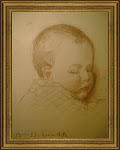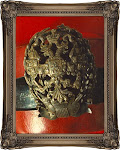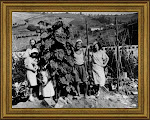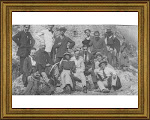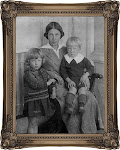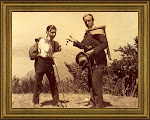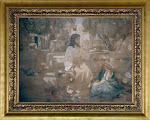
Gregorij Pavlovic Maltzeff was born in Talashmanonvo (province of Vladimir) - Russia - on the 27th of November 1881.
He was only four years old when his mother died. His father remarried when he was seven y.o. and moved to Nijžni Novgorod with his stepmother and the two stepsisters.
At the age of sixteen he joined the Fluvial Navigational Academy to become a fluvial captain. He liked the idea of sailing the Volga river, see the beautiful panoramas and be in the open air 24 hours a day. But, since he was seven years old, also had the passion for sketching and painting although his father couldn’t afford to send him to art school. As a matter of fact, his family had to move to Astrakan, a rich port on the Vo
Training at the Academy lasted from October to March. In April the Volga river deices and the river can be used again, so cadets were sent on ships to have 'on the job training': obliged to perform any job given and getting the same wages as a ship’s boy or worker.
He gets assigned to the ship: “SAMSON” which also has a tug to be pulled along.
Soon enough everyone notices that he is more an artist than a sailor. Everyone asks for a small pencil portrait to send back home. His officers start to like him and exempt him from heavy duties (also because he was a little frail).
“BUKHARA” of the Orient Corporation. Now an officer, he still had to wait his twenty first birthday before becoming operational.
 f the Astrakan Art Museum
f the Astrakan Art Museum
(G. Maltzeff - Oarsmen on the Volga)
The biggest shipping enterprise belonged to the Nobel brothers (the same family that instituted the international prize). The family had Swedish roots but most of them were born in Russia where a large part of their business was managed. Astrakan was their main landing port. Gregorius takes duty on a ship belonging to the Nobles’, the “LOPAR”. Shortly, his fame as an artist spreads throughout the whole fleet like lightning. Chiefs and engineer commissioned Gregorius for portraits and , between duties, find time to patiently pose for him. They even suggest and promise to introduce him to the company’s owner: Emanuel Nobel, who is also a famous painters patron. For two summer in a row he is on duty on board the “LOPAR”.
In the fall of 1902 he moves to St.Petersburg with his sketches and art works and enough money to last him two months, but he doesn’t feel yet mature for the art academy. The admission exam consisted of a study of human anatomy, but he felt he wasn’t ready for this as yet. He attends a private art school instead; the “Painting Studio of Scholar Dimitri Kavkasky”, on the island of Vasilijevsky, residence of Baron Dervis. The works, he shows Prof. Kavkasky, are very much appreciated, consequently Gregorij joins the school without paying any fee whatsoever. At one condition only: all the art works Gregorij produces in the studio will remain Prof. Kavkasky’s property.
He will stay with Prof. Kavkasky, from 1902 to 1906. During this period he resides at #58, Academy of Fine Arts Lane. In 1906 and 1907 he tries out for the art academy but in both years, he fails the admission exams. He is successful in 1908, turning out to be the best of the examined students.
In this period, Emanuel Nobel, the petroleum king and his family, became his friends 
As a student, Gregorij got a monthly salary. In summertime he used to join the Nobel family, at Wiipuri in Finland, for the summer holidays.
There were annual academy competitions in which he took part with historical compositions: second prize in 1908 with “Peter the Great in Astrakan in the year 1711”, second prize in 1909 with “The Mongolian Yoke in Russia in the XIII century” and first prize with “Cossacks on the Volga”. All the prizewinning paintings can be found at Academy’s Museum. The prizes, money wise, were not much but they sure gave reputation and fame.
The time came when the Academy was just about over and Gregorij had to get ready for the fin al competition, the final diploma, the… Prix de Rom! He didn’t fear competition from other colleagues but he still wanted to prepare himself at his best.
al competition, the final diploma, the… Prix de Rom! He didn’t fear competition from other colleagues but he still wanted to prepare himself at his best.
It was a free subject. In Astrakan he studied the Asian feature of the individuals: Tartars, Calmucchians and Kirghiz. So he chose,as the subject: “St. Alexiey Metropolitan Of Moscow in the Tartar Horde”.
Gregorij studied history deeply, but in order to gather additional material, he’d had to reach the Kirghiz steppe. With a pass, provided by the General Governor of Astrakan, H. E. Sokolowsky, he reaches the Sultan Chan Gianghir who assists Gregorij, in finding the most suitable characters for his painting. It was the year 1912.
On November 4th, the painting was displayed at the Imperial Art Academy, with all the rest of the material gathered on his trip.
The professor’s counsel of the Imperial Art Academy confers him the title of Academic and the “Prix de Rom” which consists of a stay in Rome, Italy, for a period of four years with an adequate monthly check and the complete exoneration from the military draft.
On January 1st, 1914, Gregorij leaves Russia with his fiancée Marussia Fiodorvna Azaroff heading for Italy. Gregorij and Marussia will get married upon their arrival in Italy.
On March 16th, 1914, they reach Rome after visiting Venice, Naples, Amalfi, the island of Capri
Their first house in Rome was located in Via Margutta n.7, in downtown Rome.
In 1915, WWI breaks out and since many artists had to leave Italy and return to their respective countries, it was quite easy to find a bigger apartment to rent for a decent price. Gregorij found a gorgeous studio, with apartment annexed, in Corso Umberto n.4, where they will stay for the next seven years.
After the revolution took place, the monthly check vanished. The eight months still due are paid,
little at a time, by the Russian Imperial Consulate. For Gregorij and his family began a long period of hardship and uncertainty. Many times Gregorij thought of going back home but he was advised against it since the kids were still very small. But it was also a time when he witnessed sympathy and generosity. The queen Helen of Italy, native of Montenegro, gave a generous amount of help to Russian emigrates.
In 1916 she commissioned and bought from Gregorij a painting of her firstborn child and later also send him a clothing outfit for his second child; always maintaining an interest in the Maltzeff family. Even Russian aristocracy, now almost all residing abroad, organized themselves to help out their own countrymen.
Under the supervision of princess Yssupoff, a “Russian Art Workshop” was officially opened in Trinità dei Monti (Spanish Steps), which displayed for sale: carved wooden jewelry boxes, paintings, embodied garments and icons. At first Gregorij was assigned to give a hand at the Russian Library Club, located in Via delle Colonnette, where the Russian emigrants could rely on a hot meal. Gregorij was given an administrative job due to his being pedantic and honest at the same time. Occasionally he also worked as a consultant, when painting exhibits were organized, to keep the “bundle caboodle” going at its best; he was highly esteemed for his unfailing zeal and the way he could settle arguments which arose.
However recalling his ability as a painter, and the icons demands rising, he was soon put in charge of painting them. Even if for Gregorij was a genre he took up for the first time, he tackled the challenge with that impetuosity and professionalism he had naturally inborn.
Gregorij sacred painting belong to the Byzantine art, which came from Byzantium with Christianity in the 850 (circa), and renewed itself in the XIV th and XV th centuries. Here it’s a chance to mention what Father Nicolas Bok, art expert and scholar belonging to the Harvard Club of San Francisco – USA, wrote about the artist whom he met in Rome:
“Although Gregorij Maltzeff made hundreds of sacred paintings, it never could be said that it was his job so much was his talent’s passionate creativity”.
And in another article written posthumous:
“Simple and modest, he was however a most cultured man and an enthusiastic classic antiques connoisseur. This is maybe why, that in his sacred images, the deep contents and the natural composure of the images so ideally combine together”.
In 1921 the grand duchess Victoria, sister of the Russian Empress killed during the revolution, came for a visit in Rome with her husband, Grand Admiral of Britain Prince Battenberg Milfords-Haven and their children. They both wanted to visit G
Appreciation letter from
the Grand Duchess Victoria
They were very impressed by his works and commissioned him a portal (one year worth of work), partially wood engraved, surmounted by a small moon with the painted image of the Holy Virgin which would be used for the shrine of one of her sisters who was murdered and buried in Jerusalem. The completed work satisfied the Grand Duchess so much that she gave Gregorij various commissions for the Royal House of England (1922).
All works were shipped by the Stein Co.
In 1922 Princess Scaletta Ruffo raised the studio’s rent, in Via del Corso n.4, and Gregorij had to look for another location. He found it just outside of Porta St. Pancrazio, in Via Vitellia n. 17, outside Rome’s city walls, in Monteverde Vecchio (Gianiculum area).The house was owned by Mr. Carlo Latour, the owner of the well known Latour Café located near Piazza Venezia. The being away, from the downtown area, rewarded Gregorij, by having a vegetable garden and a hen house. At the time, he had already four children. Two were already gong to grade school at the Elementary School Giovanni Pascoli.
In 1925, when an
In 1926 he had an interesting commission from the Jesuits General Father to create a chapel, located in the Jesuits General House, in Borgo St. Spirito. He had to paint some huge tapestries, 6m x 4,5m, for the two side walls of the congregation’s eastern Chapel. It was the first time he was painting on canvas and, above all, in Byzantine style.
The tapestries, on both walls, represented doctors, saints and angels belonging to the eastern Church.
In the same year, Gregorij, is commissioned a portrait for Colonel Pellegrini of the Italian 13th Artillery Regiment (a WWI African campaign hero), his wife and two kids who will later become colonels themselves. Once more the family changes residence and moves back in the downtown area (Via Fregene n.15) in an old villa owned by Grand Officer Ortensio Spigarelli.
Spigarelli, a great art lover and connoisseur, commissions Gregorij a family portrait. He also invites him to Anzio, in his old Roman style villa. Everyone there trea
He also finally fulfilled his life's dream: buy a house. He managed to give a down payment, also thanks to Spigarelli's financial help, for a four room apartment close to 'Piazza St. Giovanni in Laterano', in Via Francesco Berni n. 9. The apartment was at the top floor of a tall building, very bright and sunny… ideal for a house-studio. It will take Gregorij five years to pay for the apartment and two years before he can go actually live in it since it was still inhabited by the old owner, but, in the long run, he finally owned an apartment.
The beautiful Basilica of St. Giovanni in Laterano was, for many years, playground and promenade for his children.
Not far from home were the Forums where Gregorij, almost every Sunday, in the summer season, took his family for cultural walks, since he knew every single rock of those ancient forums and, if the weather was bad? No problem… the museums were a good alternative!
In that same year, 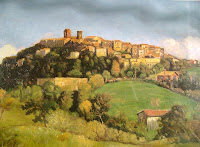
Rocca Priora meant a lot in his life. He never did adjust to the hectic city life of Rome… even in those times! He used to say that the Lazio’s Hills and its vast panoramas facing the sea and the inland on the other side, toward the Sabini mountains, reminded him somewhat of his country and also when he was navigating on the Volga river. Aside feeling a bit
It has to be said that Gregorij always looked for, and very often obtained, to grow his own ability to create without losing the practical side of things (here comes in his fluvial officer training).
Vacationing in R
The Pallottini Church commissioned him with seven more paintings and the local Parish for two.
Many other works follow, as well for the new church in Ostia, which in those year, the town, was just in the process of being built.
When he was not working, Gregorij, loved to wonder around alone, by foot, always able to discover some unknown street corners or start chatting with some shepherd or farmer who couldn’t believe their eyes and ears that a foreigner, a man of culture, a … painter could become so humble to exchange a word or two with them!!
Always refused when the few carriages and some rare cars, passing by, offered him a ride; wondering about that distinguished figure proceeding slowly along the dirt road.
Walking, according to him, was the greatest thing in the world!
He started to be known all over the Castelli Romani area and that brought in more work: the Antoniana Church in Frascati, Greek Abbey in Grottaferrata, Villa Mondragone at the Tusculum, Piglio in the Sabina area, etc.
In 1935/36 came the big opportunity: making all his sacred paintings, on wo
The works were divided as follows:
- Chapel of the Slavic Apostles Cyril and Methodius
- Chapel of Apostles Peter and Paul
- Chapel of St. Theresa of the Baby Jesus
- 2 Chapels with iconostasis for the Oriental Institute
- 1 Iconostasis for the Russicum Seminary
He then had to prepare the boards for the large Byzantine style icons on a pure gold background. Gold, at the time, came in leafs from Florence. He had, above all, to hand-carve hard-wood for the icons and decorate them with medallions containing saints and evangelists. Even if his studio was not fit for this kind of job, Gregorij went to work with the usual passion; supported by his wonderful talent.
The president of
That same year the Russicum College choose Villa Ottone, located on the Isle of Elba, as their summer residence and Gregorij was once more in charge of setting up the college chapel. This headquarters were later moved, definitely, to Roseto degli Abruzzi.
|
More or less Gregorij painted for the Russicum College for a period of twenty years and many of his works were shipped abroad. Here are some:
- Paintings for St. Maria Deificatora – Bogotà – Colombia.
- Paintings for the Harvard Club of San Francisco (Cultural Association of the USA) – USA
- Painting for the Casa Generalizia delle Suore dell’ Eucarestia – Sofia – Bulgaria.
- Paintings for the Creator’s Church – Salamanca – Spain.
Beside th
Even the Madonna Etiopica was painted by Gregorij and appears on books concerning the Virgin Mary.
It was during this profitable artistic period, and also a period of economical growth, that allowed Gregorij to fulfill another of his dreams: a country house to be built on that land he bought in Rocca Priora.
An ambitious dream for a person who made a living just on his art plus he was father to a large family. In 1937 his last son, Paul, was born. But his wife, Marussia, a very parsimonious woman, and the children who, at the time, didn’t create any problems whatsoever, encouraged him to keep on going.
The building of the house was given to the local workers, it took quite some time having high and low peaks, never actually came to a complete
In 1939/1940 Grego
The church Byzantine design required this same style, that is one of the main reasons why Gregorij was commissioned the work.
When all the works were completed, the paintings were shipped to Malta unfortunately, when WWII broke out, all contacts with the island were interrupted.
The war started and while his family, for studying or working matters, kept in Rome, with the exception of his eldest son, Nikita, who, after graduating as a doctor, was a Medical Officer in the Italian Army stationed in the Umbria region, Gregorij preferred to reside for long periods in Rocca Priora where his family went to see him when possible. There he always found work which was often or partially paid with commodities, such as: beans, oil, wine etc., which he often took to his family in Rome. He left his ration-cards to his family since he didn’t need them in the village.
Germans kept a sharp eye on Rocca Priora, as well as in all the Castelli Romani area, watched everyone closely but got, soon, used to the “foreign painter” who, starting at sunrise, worked in his vegetable garden, watered the young trees then, they could see him through the windows, sitting down behind his tripod mixing his colors and painting away.
There were quite some villagers on the war front lines and as a result the local population got thinner. The ones remaining behind felt closer to one another like it often happens in this circumstances.
In summertime, when his wife and the younger son, Paul, still a grade school student, came to Rocca Priora, the headmaster of the Pallottini College used to join them for long walks in the chestnut woods. Some other time it was Gregorius who invited the whole bunch; young seminaries included, showing and explaining them the surrounding areas and the ancient history they witnessed, then, he started speaking about art, having everyone’s unconditioned attention. He was an extraordinarily cultured man but never gave that impression; he didn’t like to be the one behind the teaching desk. In this period Gregorij made another interesting acquaintance, in Rocca Priora, which he will remember for the rest of his life: Don Elio Zaratti, a Pallottini priest, son of shepherds but out of the ordinary for his culture and his perfect knowledge of the German and English languages which will come in handy when the relations between the villagers and the German troops started to wear out and when the USAR troops came in.
Once in a while he used to go back to Rome for work. On one of this occasions he was commissioned a portrait for the Czechoslovakian ambassador, S.E. Ambassador Miroševic; then again, another commission, for a high official of the Banco Ambrosiano (the Vatican Bank), Mr. Brasati: a crucifix painted on copper, a wedding present for his daughter; one of the best Gregorij has ever made.
At the end of winter 1943 the war front coming from the southern part of Italy was getting unavoidably closer to the Castelli Romani area. The grumbling of cannons became like thunder, because of the artillery cross firing from both fronts, was turning the sky bright red. The local church’s steeple got hit; there were also some casualties and some were wounded. This got the villagers very worried and scared.
It happened in those tragic days that Gregorij was so taken by his painting that didn’t realize the artillery shells were falling closer and closer to his house. It was Don Elio who sent a couple of his seminaries to literally pick Gregorij up by force and take him to the grottoes which where used as shelter. There he found a lot of villagers who ran for shelter and were glad to see him since they were all worried about him. While Gregorij was sitting in his corner, one thought came in his mind: “th
The grottoes used as air shelters (Marfa in the photo)
The fire storm lasted a few days. When the last Germans retreated towards Rome, and all the villager left the grottoes, Gregorij rushed back home and hung a white bed sheet on the roof (you never know!). After a while he saw US Army troops moving toward the house, believing the enemy was surrendering.
It was a big surprise when they found themselves in front of a single middle aged man, definitely a foreigner, wearing a robe smeared with all the colors of the rainbow, and more: smiling both ingenuously and maliciously, with grey-green short-sighted eyes, surrounded by a few lost looking villagers who were looking at the “foreigner” as to ask him: '... now what??'.
The soldiers decided that he was the leader of the “wild bunch” and started to ask him for: “acqua!”, “acqua!” (water!)
Gregorij replied instantly: “but you speak Italian?” He kept on talking while opening the faucets of the rainwater tank and started giving out water which was avidly drank; many soldiers dipped their canteen directly into the water tank. When everyone was satisfied, and the initial tension dropped, smiles, hand shakes and cigarettes were passed around. Various Italian dialects, with a heavy Yankee accent, could be heard filling the air. Everyone was moved, and some tears also moistened a few cheeks.
Gregorij continued to reside in Rocca Priora, growing his vegetable garden and his trees and, above all… he diligenlty kept on painting!
From a letter that he wrote to his son Nikita, the Lt. Doctor now joined with the 5th Army, it came to be known that the artist was commissioned, by the local villagers, to paint a votive banner which was going to be dedicated to the Sanctuary of the 'Divino Amore' located about 12 km. from Rome. As Gregorij wrote to Nikita, the villagers who were former war prisoners, came to pose for him in their British prison camp uniforms which they wore in Africa and that were jealously kept a s a memento.
The painting represents the Madonna looking, from above, and addressing the prisoners, the wounded; with their clothes shredded who, kneeling, are praying Her while the land and air war keeps flaming around them.
When the banner was ready it was displayed in the local 'St. Maria della Neve' church, the villagers wanted to keep it for a little while longer instead of sending it to the Divino Amore right away. Fresh flowers were brought in all day round, and people came to admire the art work continuously. At any time of the day.
Only in September, on the day of the Virgin Mary, the banner was taken by foot, with a big procession, from Rocca Priora to the Divino Amore, with a lot of endurance from the villagers.
In 1949 news came from Malta: this time the island’s British, Maltese and Greeks have decided to rebuilt the church of St. Maria Damascena more beautiful than it
The church was severely damaged by the bombings which just about destroyed the entire island. The Maltese community wanted the church to be rebuilt in pure XII century-Byzantine style and Gregorij, obviously, was commission the pictorial work.
In 1950 the artist was personally invited to Malta for the finalize the agreements undertook with Father George Schirò, who, at the time, was the local parson .
Gregorij was very enthusiast after seeing the island which he undoubtedly considered it a Mediterranean man-made jewel .
Gregorij was deeply impressed by Malta. He kept talking about it until he lived. Also the welcome, give
When the paintings were ready they got shipped by CIT a company which, at that time, specialized in shipments of art pieces, throughout the world, and also took care of all the paper work required.
Some time after, another call to Malta came in for Gregorij: to place and arrange the paintings within the church. For the first time he flew on a plane: his fears disappeared when he saw some kids who were not the least preoccupied nor scared to fly, on the contrary, they were joyful and laughing
That of Malta was his last earthly fatigue. A tumor was seriously threatening his alth
Gregorij Pavlovic Maltzeff passed away on the 10th of March 1953 at the age of 71 y.o. after a few months of suffering. He is buried in Umbria with his beloved wife, in the family tomb, in a countryside cemetery, not far from the town of Spoleto. He is surrounded by wheat field and olive trees. He found peace in the countryside which he always loved and dreamed about and which reminded him of the happy years he spent with his grandparents.
- By Varvara Gregorivna Maltzeff - Translation by Michael Axel Maltzeff-McCain
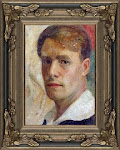



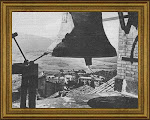


















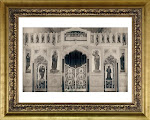


.jpg)
